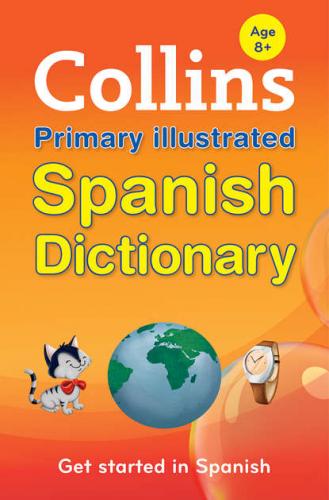• it introduces young learners to all the basic elements of a bilingual dictionary and provides detailed instructions on how to get the most out of using the dictionary
The Collins Primary Illustrated Spanish Dictionary is presented in an easy-to-use format which is intended to appeal to children of primary school age. It provides lots of simple, relevant examples and tips on how to remember words, and how to avoid some of the pitfalls of translation. It also features key phrases, illustrations and information about life in Spain, making it an invaluable and exciting new resource.
Step one:
Pick the right side
Remember there are two halves to the dictionary. If you want to know what a Spanish word means, look in the first half of the dictionary.
If you want to translate an English word into Spanish, look in the second half, which is English-Spanish. It comes after the supplement in the middle of the dictionary.
1 Which of these words would you look up on the Spanish-English side of the dictionary?
ver brother horse teléfono
2 Look at page 51 of the dictionary. Is this the Spanish side or the English side? How can you tell?
3 Look at page 150 of the dictionary. What is shown at the top of the page, down the side?
4 Is invite the first or the last word on page 437?
Remember that you do not read across the whole page in a dictionary – you have to read down the columns.
5 Which word comes immediately after aburrido?
Step two:
Find the right word
A B C D E F G H I J K L M N O P Q R S T U V W X Y Z
Words are in alphabetical order in the dictionary – like names in the phone book, and in a school register. The alphabet is shown down the edge of each page of the dictionary. You can sort words into alphabetical order by looking at the first letter of each word.
6 Can you put these names in alphabetical order?
María, Isabel, Juan, Jorge, David, Arturo, Carmen
When two words start with the same letter, look at their second letters.
7 In alphabetical order which comes first – Juan or Jorge?
8 This is the order of the days of the week on a calendar:
Monday, Tuesday, Wednesday, Thursday, Friday, Saturday, Sunday
Which day comes first in a dictionary? Which comes last?
9 Thursday comes before Tuesday in a dictionary. Why?
10 Put the seven days of the week into alphabetical order. If the first letters are the same, and the second letters are the same, look at the third letters.
11 June, July, August: which comes last in the dictionary?
Step three:
Pick the right translation
The translations are easy to spot in this dictionary because they are blue on the English-Spanish side and red on the Spanish-English side.
Spanish words can be masculine or feminine, and singular or plural. In the dictionary you will come across the abbreviations masc and fem, which tell you the gender of a Spanish word. PL tells you the word is plural. The dictionary also shows you the Spanish word for ‘the’ (this can be el, la, los or las). In the Language plus supplement, NOUN is abbreviated to N and ADJECTIVE is abbreviated to ADJ.
When you look up ‘doll’ you can see that the word for ‘doll’ in Spanish is muñeca. You can tell that the Spanish word for ‘doll’ is feminine because it is given with la and the dictionary says that it is ‘fem ’ (feminine).
So ‘the doll’ is la muñeca and ‘a doll’ would be una muñeca.
Sometimes there is more than one translation, and each one has a number. If there is more than one translation, don’t just pick the first one! Check to see which is the right one.
12 Which is the Spanish word for a ball that you kick – la pelota or el balón? Look for the clue.
ball NOUN
1 la pelota fem (for tennis, golf, cricket) Hit the ball! ¡Dale a la pelota!
2 el balón masc (PL los balones) (for football, rugby) Pass the ball! ¡Pasa el balón!
Step four:
Parts of Speech
Sometimes, to pick the right translation, you need to know the part of speech of a word, for example whether a word is a noun, an adjective, an adverb or a verb.
NOUNS
Nouns are naming words for things or people. You often use the words ‘a’ or ‘the’ with a noun – eg a girl, a boy, the school, the windows.
Nouns can be singular, eg an accident, the playground, my dad, football – or plural, eg sweets, the children, my friends.
13 How many nouns are there in this sentence? What are they? The car has got a flat tyre and a big dent in the door.
ADJECTIVES
An adjective is a describing word which tells you what things are like: flat shoes are shoes that don’t have high heels. A flat tyre is a tyre with no air in it.
14 How many adjectives are there in this sentence? What are they? She’s got brown hair and blue eyes.
Some words have a noun meaning and an adjective meaning. In the dictionary there is a box to tell you about this. The different meanings usually have different translations in Spanish.
patient
patient can be a noun or an adjective.
A NOUN
el/la paciente masc/fem
B ADJECTIVE
paciente
